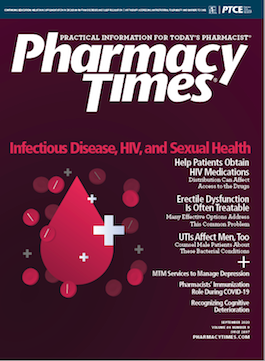Publication
Article
Pharmacy Times
Barhemsys From Acacia Pharma
Author(s):
The FDA has approved Barhemsys (amisulpride) injection from Acacia Pharma for the prevention and treatment of postoperative nausea and vomiting (PONV) in adults.
The FDA has approved Barhemsys (amisulpride) injection from Acacia Pharma for the prevention and treatment of postoperative nausea and vomiting (PONV) in adults. Barhemsys may be used either alone or in combination with an antiemetic of a different class.1
PONV is associated with the use of aesthetic gases and opioid painkillers. It occurs in about 16 million Americans each year who undergo surgery, including patients who have received preventive treatment with an antiemetic medication. Approximately 30% of surgical patients and up to 80% of high-risk patients experience PONV. It is common after abdominal, breast, ear, eye, and gynecological procedures, especially those that last longer than an hour.2
PHARMACOLOGY AND PHARMACOKINETICS
Barhemsys is a selective dopamine-2 (D2) and dopamine-3 (D3) receptor antagonist. D2 receptors are located in the chemoreceptor trigger zone and respond to dopamine that is released from nerve endings, resulting in the transmission of stimuli to the vomiting center. Multiple studies suggest that D3 receptors are also involved in emesis.
Barhemsys reaches peak plasma concentration at the completion of its intravenous (IV) administration, with plasma concentrations decreasing to about 50% of the peak value within about 15 minutes. It displays a mean elimination half-life of about 4 to 5 hours.1
DOSAGE AND ADMINISTRATION
When Barhemsys is used for the prevention of PONV, either alone or in combination with another antiemetic, the dose is 5 mg IV as a 1- to 2-minute infusion at the induction of anesthesia. When used for the treatment of PONV, the dose for Barhemsys is a 10 mg IV as a 1-to-2 minute infusion.1
CLINICAL TRIALS
Barhemsys was evaluated for the prevention of PONV in 2 double-blind, multicenter, placebo-controlled, randomized trials in patients undergoing elective surgery and general anesthesia. Participants in study 1 received monotherapy with Barhemsys 5 mg IV at the induction of anesthesia. Participants in study 2 received Barhemsys 5 mg IV in combination with 1 other intravenously administered, nondopaminergic antiemetic (betamethasone, dexamethasone, or ondansetron) at the induction of anesthesia. The primary efficacy end point of both trials was complete response, which was defined as the absence of emesis or the absence of the use of a rescue medication within the first postoperative 24 hours. Compared with the placebo, Barhemsys was found to provide improved protection against PONV. Barhemsys was evaluated for the treatment of PONV in 2 double-blind, multicenter, randomized, placebo-controlled trials in patients who experienced PONV after general anesthesia and elective surgery. Study 3 consisted of participants who had not received prior PONV prophylaxis, and study 4 consisted of participants who had received PONV prophylaxis with an antiemetic of another class that did not work. Patients who received a D2 receptor antagonist antiemetic were excluded from the trial. The primary efficacy end point of both trials was complete response, defined as the absence of emesis or the absence of the use of a rescue medication within the first 24 hours after treatment, excluding emesis within the first 30 minutes. Barhemsys was found to be more effective than the placebo at treating PONV.1,2
CONTRAINDICATIONS, WARNINGS, AND PRECAUTIONS
The use of Barhemsys is contraindicated in patients with a known hypersensitivity to the medication.
Because Barhemsys causes concentration-dependent and dose-dependent prolongation of the QT interval, its use should be avoided in patients with congenital long QT syndrome and in those taking droperidol. Electrocardiogram (ECG) monitoring is recommended for patients with cardiac conduction disorders or preexisting arrhythmias, congestive heart failure, and electrolyte abnormalities, such as hypokalemia or hypomagnesemia. Patients taking other medicinal products known to prolong the QT interval or with other medical conditions known to prolong the QT interval should also have ECG monitoring. Barhemsys should not be used in patients with severe renal impairment.
When Barhemsys is used for the prevention of PONV, the most common adverse effects (AEs) are abdominal distension, chills, hypokalemia, increased blood prolactin concentrations, and procedural hypotension. When used for the treatment of PONV, the most common AE is pain at the site of infusion.1
Monica Holmberg, PharmD, BCPS, earned her PharmD at the University of Connecticut in Storrs and completed an ambulatory care residency at the Phoenix VA Health Care System in Arizona. Her practice has also included pediatrics and inpatient mental health. She lives in Phoenix.
REFERENCES
- Barhemsys. Prescribing information. Acacia Pharma Inc; 2020. Accessed May 24, 2020. https://barhemsys.com/SRC/barhemsys-amisulpride-injection-prescribing-information.pdf
- Acacia Pharma announces US approval of Barhemsys (amisulpride) for the treatment and prevention of PONV. News release. Acacia Pharma Group. February 27, 2020. Accessed May 24, 2020. http://www.acaciapharma.com/news/2020/02/acacia-pharma-announces-us-approval-of-barhemsys-amisulpride-for-the-treatment-and-prevention-of-ponv







